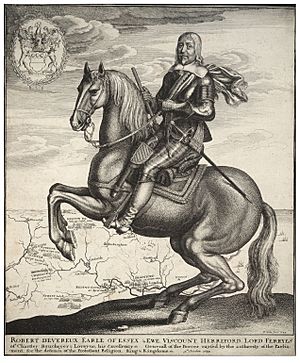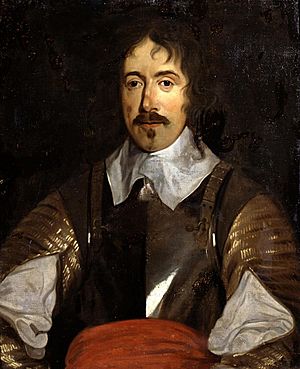Committee of Both Kingdoms facts for kids
The Committee of Both Kingdoms was an important group formed during the Wars of the Three Kingdoms. It was created in late 1643 when the English Parliamentarians teamed up with the Scottish Covenanters. They made an alliance called the Solemn League and Covenant.
This committee helped manage the war against King Charles I. It was also known as the Derby House Committee from 1647 onwards. The committee was dissolved in 1649, shortly after King Charles I was executed. It was then replaced by the Council of State.
When the Scottish army came to England in January 1644, a new committee was needed. This new group included members from both England and Scotland. On February 16, 1644, the English Parliament officially created the Committee of Both Kingdoms. Its main goal was to manage peace talks or continue the war against the King.
Forming the Committee
In January 1644, Scottish leaders in Edinburgh decided to send a special group to London. This group had full power to represent Scotland.
The four Scottish members were:
- Earl of Loudoun—Scotland's top legal officer
- Lord Maitland—already in London
- Lord Warriston—also coming to London
- Robert Barclay—a leader from Irvine
On February 5, these Scottish members met with the English Parliament. To make sure both countries worked together, the English Parliament passed a rule on February 16. This rule created the joint "Committee of the Two Kingdoms."
The committee included seven members from the English House of Lords. It also had fourteen members from the House of Commons. At least six members had to be present for decisions. This group always needed one Lord for every two Commoners. For the Scottish members, at least two had to be present.

The seven members from the House of Lords were:
- Algernon, Earl of Northumberland (1602–1668)—a leader who wanted peace.
- Robert, Earl of Essex (1591–1646)—the first main general of the Parliament's army.
- Robert, Earl of Warwick (1587–1658)—Parliament's top naval commander.
- Edward, Earl of Manchester (1602–1671)—a general who fought at Marston Moor.
- William, Viscount Saye and Sele (1582–1662)—helped pass an important rule about army leaders.
- Philip, Lord Wharton (1613–1696)—a younger member and a favorite of Oliver Cromwell.
- John, Lord Roberts (1606–1685)—lost his army command later on.
The fourteen members from the House of Commons were:
- William Pierrepoint (c. 1607–1678)—a Member of Parliament who talked with the King.
- Henry Vane the Elder (1589–1655)—a former government secretary.
- Sir Philip Stapleton (1603–1647)—a cavalry commander.
- Sir William Waller (c. 1597–1668)—a major general for Parliament.
- Sir Gilbert Gerard (1587–1670)—managed the army's money.
- Sir William Airmine (1593–1651)—later joined another important council.
- Sir Arthur Haselrig (1601–1661)—a knight from Leicestershire.
- Henry Vane the Younger (1613–1662)—a Member of Parliament from Kingston upon Hull.
- John Crew (1598–1679)—a Member of Parliament and a judge.
- Robert Wallop (1601–1667)—a Member of Parliament from Andover.
- Oliver St John (c. 1598–1673)—a lawyer and judge, related to Oliver Cromwell.
- Oliver Cromwell (1599–1658)—a Member of Parliament from Cambridge, who later became Lord Protector.
- Samuel Browne (c. 1598–1668)—a Member of Parliament from Dartmouth.
- Serjeant John Glynne (1602–1666)—a Member of Parliament from Westminster.
Some people, like the Earl of Essex, were not happy with how the committee was set up. They felt it took away some of their power in managing the war.
How the Committee Worked
The Committee met every day, even Sundays, at Derby House. They usually met at three o'clock in the afternoon. In 1644, attendance was sometimes low because many members were also army commanders. For example, Lord Warwick was the head of the navy.
The most active members were Lord Wharton and Henry Vane the Younger. For the Scots, Lord Warriston was very influential. The committee had to deal with different groups and disagreements among its members. For instance, there were tensions between Waller and Essex.
The committee's biggest success was creating the New Model Army. They also made sure this army and other forces had what they needed to fight. This continued until King Charles was defeated in 1646. The Committee provided a steady way to manage the war, which the King could not match.
End of the Committee

On April 27, 1646, King Charles I left Oxford and gave himself up to the Scottish army near Newark. The Scots then took the King north to Newcastle. In July, the Committee offered Charles a deal called the Newcastle Propositions. This included him agreeing to a unified church between England and Scotland.
When Charles refused the terms, the Scots were in a tough spot. Keeping him was risky. On January 28, 1647, they handed Charles over to the English Parliament for £400,000. Then they went back to Scotland.
The Committee of Both Kingdoms was officially dissolved. However, its English members continued to meet as the Derby House Committee. This group was led by Denzil Holles and other moderate Members of Parliament.
At this time, there were many problems. The war had caused money issues, and the harvest failed in 1646. By March 1647, the New Model Army was owed a lot of unpaid wages. Parliament ordered the army to go to Ireland, saying only those who agreed would be paid. But the soldiers refused to go without full payment first.
In response, Holles and his allies tried to create a new army. But on July 21, many Members of Parliament left London and joined the New Model Army. On August 6, the army marched into London. They dissolved the Derby House Committee and demanded that some Members of Parliament be removed.

